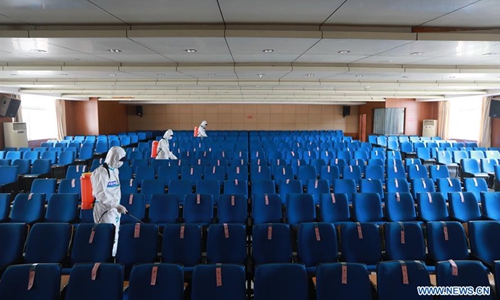Hubei lowers COVID-19 response level, retains strict residential community management
Source:Global Times Published: 2020/5/1 16:20:13 Last Updated: 2020/5/1 21:22:27

Firefighters carry out disinfection to the lecture hall at the No. 23 Senior High School in Wuhan, central China's Hubei Province, April 22, 2020.Photo:Xinhua
Central China's Hubei Province announced on Friday that it is to lower the public emergency response level for COVID19 from level one to two starting from May 2, according to a press conference on Friday That means 31 provinces in China have deactivated their firstlevel public emergency response.
According to the Friday press conference, zero domestic and imported case was reported in Hubei on Thursday, marking the 27 consecutive days without new COVID19 cases in Hubei, and 57 consecutive days clear in the province except for its capital city, Wuhan.
Li Yang, deputy director of Hubei Provincial Center for Disease Control and Prevention, said at the press conference that a total of 68,128 COVID19 cases had been reported in Hubei as of 12 pm, April 30, among which, 50,333 are in Wuhan, and 17,795 in other cities of the province.
As of April 30, the death toll of the COVID19 in Hubei was 4,512 and 63,616 patients had been cured and discharged from hospitals.
On April 30, 19 asymptomatic carriers were reported and 11 were relieved from quarantine in Hubei, and 631 asymptomatic carriers are under medical observation as of Thursday.
Liu Dongru, deputy head of Hubei's health commission, said at the press conference that epidemic control department above the county level in the province will still be standby for 24 hours every day to guarantee effective coordination between public health and medical service departments for prevention work.
Additionally, Hubei will continue to strengthen management work on people entering Hubei from other countries, establish a closed management for transferring and group quarantine of imported cases, strengthen management on asymptomatic carriers, and expand testing scale in schools, supermarkets, and transportation stations.
Li Tao, deputy secretarygeneral of Wuhan city government, said at the conference that Wuhan would maintain strict measures in managing residential communities, including taking residents' temperatures and asking them to wear masks; and hightech devices are encouraged to be used.
Posted in: SOCIETY